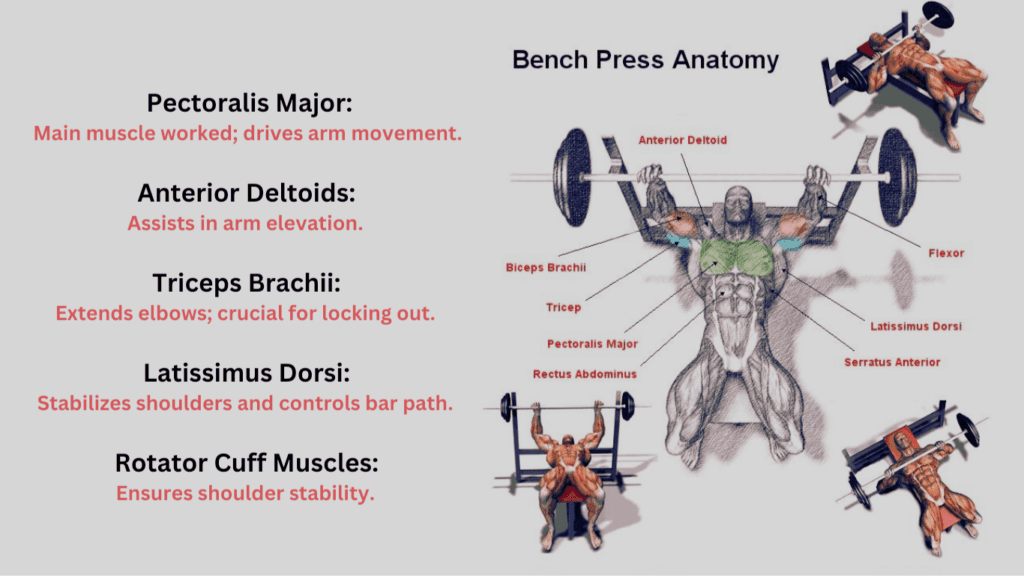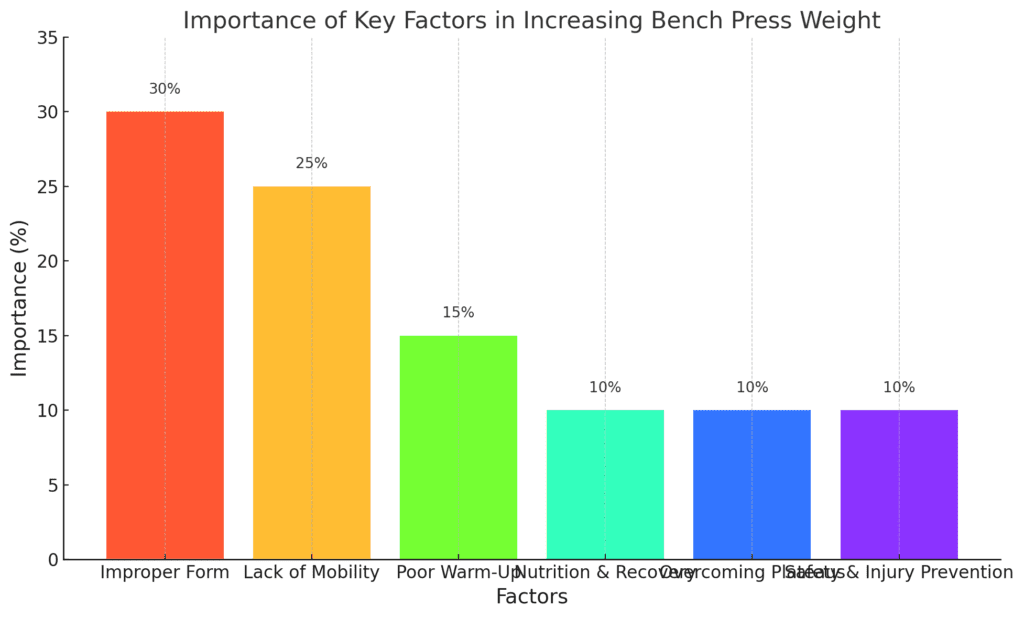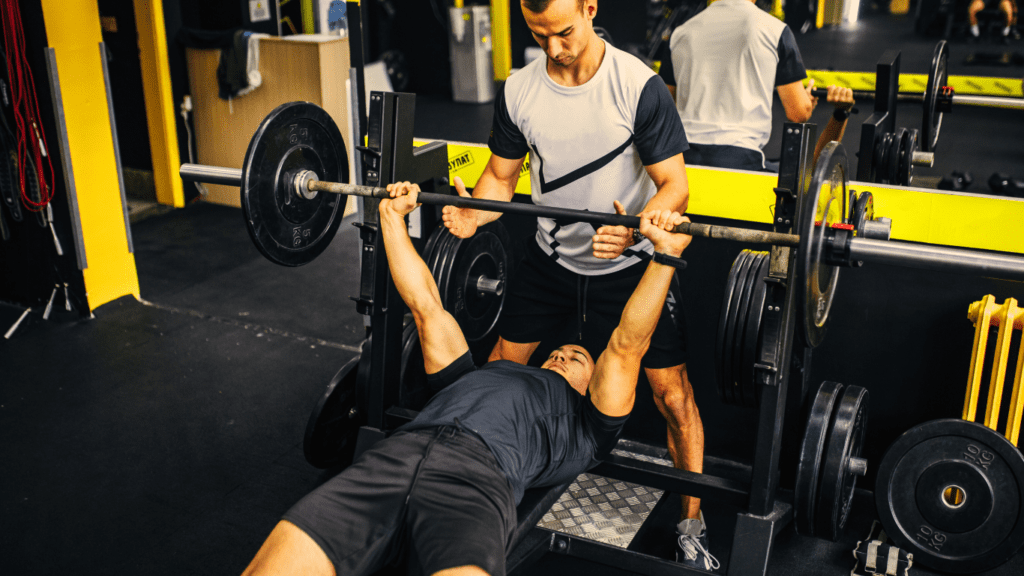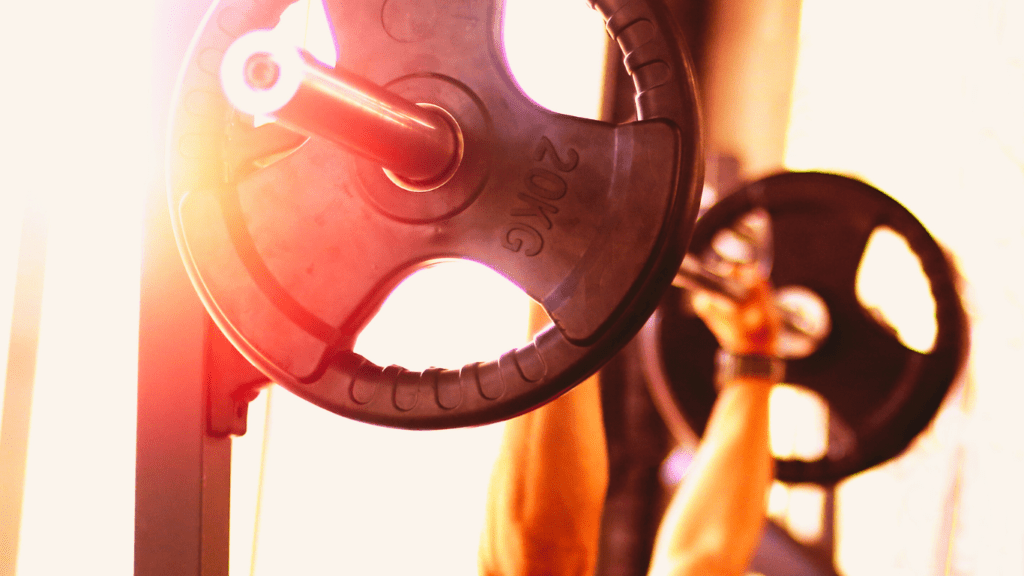The Foundations of How to Bench Press More Weight
In this article, you’ll learn how to bench press more weight by mastering techniques, avoiding common mistakes, and tailoring your training for powerlifting, bodybuilding, and overall fitness success.
The bench press is one of the most fundamental exercises in strength training and powerlifting, acting as a cornerstone for building upper body strength. Whether you’re aiming to improve your performance in competitions or simply looking to enhance your overall fitness, understanding how to bench press more weight is essential. The ability to increase the weight you can bench press not only showcases your power but also contributes significantly to your overall muscular development and endurance.

In this article, we’ll dive deep into the practical strategies and scientific principles that can help you bench press more weight. By providing actionable advice, we’ll guide you through the process of improving your bench press technique and overall strength. This article isn’t just for seasoned powerlifters—it’s also designed to help bodybuilders, fitness enthusiasts, and anyone looking to maximize their bench press potential. No matter where you are in your fitness journey, these insights will be beneficial.
The journey to mastering the bench press and lifting heavier weights requires a comprehensive approach. We will start by discussing the basics—Understanding the Bench Press. It’s crucial to understand the mechanics and principles behind the exercise before attempting to lift more weight. Then, we’ll look into Common Mistakes and How to Fix Them, because even small errors in form or approach can hinder your progress and lead to injuries.
Next, we’ll explore Building a Strong Foundation—a critical step for anyone serious about bench pressing more weight. This section will cover the importance of developing overall strength, stability, and proper technique. For those looking to push their limits further, Advanced Techniques for Powerlifters will introduce more specialized methods to increase your bench press capacity.
Subscribe And Get Our Free E-Book:Unlocking The Power Of Nutrition-Supplements, Substitutes, and Superfoods!
Nutrition and recovery play an equally important role in your ability to bench press more weight. In the Nutrition and Recovery section, we’ll discuss how what you eat and how you recover can directly impact your performance. Tailoring your approach based on your specific goals is also crucial, which is why we’ll include a section on Tailoring Advice for Different Goals. Whether you’re aiming for strength, hypertrophy, or endurance, your strategy should reflect your objectives.
Overcoming plateaus is a common challenge when trying to increase your bench press. In the Overcoming Plateaus section, we’ll provide strategies to help you break through these barriers and continue making progress. Finally, safety is paramount, so we’ll conclude with Safety and Injury Prevention tips to ensure that you can keep pushing yourself without risking injury.
By the end of this article, you’ll have a clear, actionable plan on how to bench press more weight, whether you’re just starting or looking to fine-tune your approach. The advice is grounded in science and experience, ensuring that you have the best possible guidance on your journey to a stronger bench press. Stay tuned as we delve into each of these topics in detail, providing you with the tools and knowledge you need to lift more confidently and effectively.
Understanding the Bench Press
To effectively learn how to bench press more weight, it’s crucial to first understand the mechanics and anatomy involved in the movement. A well-executed bench press isn’t just about pushing the bar up and down—it’s about engaging the right muscles, maintaining proper form, and leveraging your body’s biomechanics to maximize strength and minimize injury.

When it comes to the primary muscles engaged in the bench press, the pectoralis major plays the starring role. This large chest muscle is responsible for the pressing motion, helping to move the barbell away from your chest during the concentric phase of the lift. Alongside the pecs, the deltoids—particularly the anterior deltoids—contribute significantly to the pressing motion. They assist in pushing the bar upward by flexing the shoulder joint. The triceps, located at the back of your upper arms, are also key players. They extend the elbows during the final phase of the lift, locking out the arms at the top.
While these primary muscles do the heavy lifting, supporting muscles are equally important in ensuring a strong and stable bench press. The rotator cuff muscles, for example, are small but crucial stabilizers of the shoulder joint. They keep the shoulder stable as you press, preventing injuries and maintaining proper form. The latissimus dorsi (lats), although more commonly associated with pulling movements, also play a vital role in the bench press. Engaging the lats helps to create a solid base of support, stabilizing your body and keeping your shoulder blades retracted, which is essential for a powerful press. Lastly, your core muscles—including the abdominals and lower back—are responsible for maintaining stability throughout the movement. A strong core ensures that your body remains tight and aligned, preventing energy leaks that can reduce your pressing power.
Understanding the biomechanics of the bench press is just as important as knowing the muscles involved. The movement pattern of a bench press can be broken down into three phases: the concentric, eccentric, and isometric phases. The concentric phase is the upward motion, where you press the bar away from your chest. This is where your pectorals, deltoids, and triceps work together to generate the force needed to lift the weight. The eccentric phase is the downward motion, where you lower the bar back to your chest. During this phase, the muscles lengthen under tension, which is crucial for building strength and controlling the weight. Finally, the isometric phase occurs at the point of transition between lowering and pressing the bar. This is when your muscles are under the most tension, and maintaining tightness is essential for a smooth and powerful lift.
The leverage you have in the bench press is influenced by several factors, including grip width and bar path. Grip width determines how much emphasis is placed on different muscles. A wider grip tends to put more focus on the pectoral muscles, while a narrower grip shifts the emphasis to the triceps. However, the ideal grip width varies from person to person and depends on factors such as arm length, shoulder width, and personal comfort. Experimenting with different grip widths can help you find the position that allows you to generate the most force and press the most weight.
The bar path—the trajectory that the barbell follows during the lift—is another critical factor in bench press performance. The most efficient bar path is typically a slight arc, with the bar moving from above the lower chest at the bottom of the lift to over the shoulders at the top. This path allows you to engage more muscle fibers and reduces unnecessary strain on the shoulders. A straight up-and-down path might seem logical, but it can actually decrease your pressing power and increase the risk of injury.

Here’s a chart that highlights the importance of various factors in increasing bench press weight, which complements the article’s content.
Importance of Key Factors in Increasing Bench Press Weight
- Improper Form (30%): Mastering proper form is crucial for maximizing lifting efficiency and minimizing injury risk.
- Lack of Mobility (25%): Improving mobility in shoulders, wrists, and thoracic spine significantly enhances performance.
- Poor Warm-Up (15%): A proper warm-up prepares your muscles for the lift and prevents injuries.
- Nutrition & Recovery (10%): Proper nutrition and recovery play vital roles in muscle development and strength gains.
- Overcoming Plateaus (10%): Learning strategies to overcome training plateaus ensures continued progress.
- Safety & Injury Prevention (10%): Prioritizing safety helps maintain consistent training without setbacks due to injuries.
One of the most overlooked aspects of how to bench press more weight is the importance of a proper setup and maintaining tightness throughout the lift. Before even unracking the bar, it’s essential to set up correctly. Start by lying on the bench with your eyes directly under the bar. Retract your shoulder blades by pinching them together, and press them into the bench to create a stable base. This not only protects your shoulders but also allows you to engage your lats effectively. Next, plant your feet firmly on the ground, slightly behind your knees, to create a strong leg drive. Your feet should remain in this position throughout the lift, as driving through your legs can help transfer more power to the bar.
Maintaining tightness in your entire body is key to a successful bench press. Imagine your body as a coiled spring—every muscle should be engaged and ready to explode with power. Keep your core braced, your glutes tight, and your legs pushing into the ground. This full-body tension not only stabilizes you on the bench but also maximizes the force you can apply to the barbell. Losing tightness at any point during the lift can lead to energy leaks, making it harder to press more weight and increasing the risk of injury.
In summary, to truly understand how to bench press more weight, you must first grasp the anatomy and biomechanics of the lift. By knowing which muscles are involved, how the movement is executed, and the importance of proper setup and tightness, you can lay a strong foundation for increasing your bench press strength. This knowledge is not just theoretical—it has practical implications that, when applied, will lead to noticeable improvements in your bench press performance.
Common Mistakes and How to Fix Them
When it comes to how to bench press more weight, mastering proper form and avoiding common mistakes is crucial. Many lifters encounter issues that can hinder their progress and even lead to injuries. Understanding these pitfalls and learning how to correct them will help you achieve better results and lift more effectively. Let’s dive into some of the most common mistakes and how to address them.

Mistake 1: Improper Form
One of the primary factors affecting your ability to bench press more weight is improper form. Common form issues can drastically reduce your lifting efficiency and increase the risk of injury.
Flared Elbows: When your elbows flare out too much during the bench press, it places undue stress on your shoulder joints and can limit your power output. To correct this, keep your elbows at a 45-degree angle to your torso. This position allows your chest and triceps to engage more effectively and helps protect your shoulders. Imagine pulling your elbows down and back as you press the bar up. This adjustment ensures that you are using the right muscles and moving the bar through an efficient path.
Lack of Leg Drive: Many lifters neglect the importance of leg drive, which can significantly impact your bench press performance. Without proper leg drive, you miss out on potential power generated from your lower body. To fix this, plant your feet firmly on the ground and drive through your heels. Your legs should be actively engaged, pushing into the ground to help you press the bar. Maintain this tension throughout the lift to create a more stable base and transfer more force to the barbell.
Uneven Bar Path: An uneven bar path often results from improper form or muscle imbalances. The bar should move in a slight arc, starting from above your chest and ending over your shoulders. To correct this, focus on lowering the bar to the same spot on your chest each time. You can use a spotter or visual cues to ensure consistency. If the bar drifts to one side, it might indicate strength imbalances or a need to refine your technique.
Mistake 2: Lack of Mobility
Poor Mobility in the shoulders, wrists, or thoracic spine can severely limit your bench press performance. Limited range of motion not only affects your form but also your ability to press more weight effectively.
Shoulder Mobility: Tight shoulders can restrict your ability to lower the bar fully and press it efficiently. To improve shoulder mobility, incorporate stretches such as the doorway stretch and shoulder dislocations using a resistance band. These exercises help increase flexibility and range of motion in the shoulder joints.
Wrist Mobility: Limited wrist flexibility can cause discomfort and affect your grip on the bar. To enhance wrist mobility, perform stretches like wrist flexor and extensor stretches. Additionally, try using wrist wraps to provide extra support and alleviate strain during the lift.
Thoracic Mobility: A stiff thoracic spine can prevent proper bar path and reduce power output. Improve thoracic mobility with exercises such as foam rolling and thoracic extensions. These techniques help maintain a neutral spine position and allow for better overall movement during the bench press.
Mistake 3: Poor Warm-Up
A proper warm-up is essential for both performance and injury prevention. Neglecting to warm up adequately can lead to muscle strains, joint issues, and suboptimal lifting performance.
Dynamic Stretches: Start your warm-up with dynamic stretches to increase blood flow and prepare your muscles for the lift. Exercises such as arm circles, shoulder shrugs, and bodyweight squats activate the muscles used in the bench press and improve flexibility. Aim for about 5-10 minutes of dynamic stretching to get your body ready for the workout.
Activation Exercises: Follow up with activation exercises to target the specific muscles you’ll be using. Perform movements such as band pull-aparts, push-up pluses, and light bench press sets with just the bar or light weights. These exercises help engage your chest, shoulders, and triceps, ensuring they are primed for the heavier sets to come.
Sample Warm-Up Routine:
- Dynamic Stretching (5-10 minutes):
- Arm Circles: 2 sets of 15 reps each direction
- Shoulder Shrugs: 2 sets of 15 reps
- Bodyweight Squats: 2 sets of 15 reps
- Activation Exercises (5 minutes):
- Band Pull-Aparts: 2 sets of 15 reps
- Push-Up Plus: 2 sets of 10 reps
- Light Bench Press: 2 sets of 10 reps with just the bar
Incorporating these warm-up strategies helps to reduce the risk of injury and ensures that you are performing at your best during your bench press workout.
By understanding and addressing these common mistakes—improper form, lack of mobility, and poor warm-up—you can significantly improve your ability to bench press more weight. Ensuring proper technique, maintaining mobility, and preparing your body adequately will contribute to more effective and safer lifting, ultimately helping you achieve your strength goals.
Building a Strong Foundation: Essential Steps on How to Bench Press More Weight
To achieve significant gains in your bench press and truly understand how to bench press more weight, it’s crucial to focus on building a strong foundation. This involves mastering your technique, employing progressive overload, and incorporating accessory work to address weak points. Each of these components plays a vital role in enhancing your bench press strength and overall performance.

Technique Mastery
Before you start adding more weight to the barbell, it’s essential to master the bench press technique. Proper form not only maximizes your strength output but also reduces the risk of injury. Let’s break down the perfect bench press setup and execution.
Setting Up: Begin by lying flat on the bench with your eyes directly under the bar. Grip the barbell with your hands slightly wider than shoulder-width apart. Your feet should be firmly planted on the ground, creating a stable base. Retract your shoulder blades and press them into the bench. This positioning helps to stabilize your shoulders and creates a solid base for pressing.
Executing the Bench Press: As you lift the bar off the rack, ensure that your arms are fully extended but not locked out. Lower the bar slowly and controlled to your chest, keeping your elbows at a 45-degree angle to your torso. This position engages your pectorals and triceps effectively while minimizing shoulder strain. Push the bar back up to the starting position, maintaining a steady and controlled movement.
Key Cues:
- Tight Core: Engage your core throughout the lift to maintain stability and prevent unnecessary movement. A tight core acts as a foundation, helping to transfer power efficiently from your legs and upper body to the barbell.
- Squeeze the Bar: Grip the bar firmly and imagine trying to bend it slightly. This action engages your forearms and shoulders, enhancing your overall pressing power.
- Drive with Your Legs: Although it may seem counterintuitive, using your legs to drive into the ground helps create a more powerful lift. Engage your legs to maintain stability and generate additional force during the press.
Progressive Overload
Understanding and applying progressive overload is fundamental to increasing your bench press strength. Progressive overload involves gradually increasing the demands placed on your muscles to stimulate growth and strength gains. Here’s how to effectively incorporate this principle:
Increasing Weight: Start by adding small increments of weight to the barbell. For instance, increase the load by 5-10 pounds each week. This gradual progression ensures that your muscles are consistently challenged without risking injury. It’s crucial to listen to your body and adjust the increments based on how you feel during your workouts.
Increasing Volume: Volume refers to the total amount of work done, typically measured by the number of sets and reps. To promote muscle growth and strength, increase your volume by adding additional sets or reps to your workout. For example, if you normally do 3 sets of 8 reps, try increasing to 4 sets of 10 reps. This approach helps to continually stimulate muscle adaptation.
Increasing Intensity: Intensity can be ramped up by incorporating techniques such as drop sets, supersets, or paused reps. For instance, perform a set to failure, then immediately reduce the weight and continue lifting. These techniques push your muscles beyond their usual limits, fostering greater strength and size gains.
Accessory Work
In addition to perfecting your technique and employing progressive overload, incorporating accessory exercises is key to addressing weak points and enhancing your bench press. Accessory work targets specific muscle groups that support the bench press, helping to build a more balanced and powerful upper body.
Triceps Strength: The triceps play a significant role in the locking out phase of the bench press. Exercises like the close-grip bench press and tricep dips are excellent for strengthening the triceps. Perform close-grip bench presses with your hands closer together on the bar to emphasize tricep engagement. Tricep dips can be done using parallel bars or a bench to target the triceps and improve locking strength.
Shoulder Strength: Strong shoulders are crucial for stabilizing the barbell and improving overall pressing power. The overhead press is a great accessory exercise that strengthens the deltoids and upper back. By pressing a barbell or dumbbells overhead, you build shoulder strength and endurance, which translates to better bench press performance.
Upper Back Strength: A strong upper back helps stabilize your shoulder blades and maintain proper form during the bench press. Incorporate exercises like rows and face pulls to target the upper back and rear deltoids. Rows, whether performed with dumbbells, barbells, or cables, build the muscles between your shoulder blades. Face pulls strengthen the rear deltoids and upper back, supporting better bench press stability.
Transfer to Bench Press: Each of these accessory exercises enhances your bench press by addressing specific weaknesses. Stronger triceps improve your lockout strength, while robust shoulders and upper back muscles provide better stability and support. Incorporating these exercises into your routine helps to build a well-rounded upper body, translating into more weight lifted on the bench press.
In conclusion, to effectively learn how to bench press more weight, focusing on technique mastery, progressive overload, and accessory work is essential. Mastering your form ensures safety and effectiveness, while progressive overload drives continuous strength gains. Accessory exercises address specific weaknesses and enhance overall performance. By building a strong foundation in these areas, you’ll be well-equipped to increase your bench press strength and reach your lifting goals.
Chart: Factors Influencing Bench Press Performance
| Factor | Description | Impact on Bench Press Performance |
|---|---|---|
| Training Methods | The type of training (e.g., hypertrophy vs. strength phase) | Proper programming can optimize muscle gains and strength increases, leading to higher lifts. |
| Recovery Strategies | Importance of rest, nutrition, and sleep | Adequate recovery enhances muscle repair and growth, preventing overtraining and injury. |
| Common Mistakes | Errors in form, not engaging core, or improper warm-up | These can lead to injuries or plateaus, hindering performance gains. |
| Frequency of Training | Number of bench press sessions per week | More frequent, well-structured sessions can lead to faster progress, provided recovery is managed. |
| Mental Focus | The psychological aspect of lifting (visualization, mindset) | Mental preparation can enhance performance, helping lifters push past barriers during lifts. |
| Equipment Utilization | Use of belts, wrist wraps, and lifting aids | Proper equipment can provide stability and confidence, allowing lifters to push heavier weights safely. |
| Periodization Techniques | Structured cycles of training intensity and volume | Prevents stagnation and overtraining, ensuring continuous improvement. |
Additional Insights
- Training Methods: Highlight the difference between hypertrophy-focused training and strength-specific workouts to clarify when to implement each.
- Recovery Strategies: Emphasize the role of nutrition, especially protein intake, and the significance of sleep in muscle recovery.
- Mental Focus: Consider providing techniques for improving mental focus, like visualization or goal-setting strategies.
Advanced Techniques for Powerlifters
For those serious about increasing their bench press strength, mastering advanced techniques is crucial. These methods go beyond basic training principles, offering specialized approaches to enhance performance and push past plateaus. To understand how to bench press more weight, you need to delve into concepts such as periodization, speed work, and specialized techniques. This section will provide a comprehensive guide to these advanced strategies.

How to Bench Press More Weight: Periodization and Programming
Periodization is a systematic approach to training that involves structuring your workouts into cycles to maximize performance gains and prevent overtraining. Understanding how to apply periodization can significantly improve your bench press performance.
Training Cycles: Typical periodization involves several phases, each with a specific focus:
- Hypertrophy Phase: This phase emphasizes muscle growth and is characterized by higher volume (more sets and reps) and moderate weights. The goal is to increase muscle mass, which contributes to a stronger bench press.
- Strength Phase: Following hypertrophy, the focus shifts to increasing maximal strength. This phase involves lifting heavier weights for fewer reps, typically 1-6 reps per set. The aim is to improve the maximum amount of weight you can lift.
- Peaking Phase: In this final phase, the goal is to peak for a specific event or test. The intensity is high, with lower volume and a focus on lifting your maximum weight with optimal technique.
Linear vs. Undulating Periodization: There are two main approaches to periodization:
- Linear Periodization: This method involves gradually increasing intensity while decreasing volume over a training cycle. For instance, you might start with higher reps and lower weight, then progressively increase the weight and decrease the reps as you move towards your peak phase.
- Undulating Periodization: In contrast, undulating periodization varies intensity and volume within a shorter time frame, such as weekly or even daily. This approach provides frequent changes in the training stimulus, which can help to prevent plateaus and keep the body adapting.
Example Program:
- Weeks 1-4 (Hypertrophy): 4 sets of 8-12 reps at 65-75% of 1RM (one-rep max).
- Weeks 5-8 (Strength): 4 sets of 4-6 reps at 80-90% of 1RM.
- Weeks 9-12 (Peaking): 3 sets of 1-3 reps at 90-95% of 1RM, with reduced volume.
Speed Work and Plyometrics
Dynamic Effort Work: Speed work is designed to improve your explosive strength and power, which are crucial for lifting heavier weights. Speed bench press involves using lighter weights (around 50-60% of 1RM) and focusing on lifting the bar as quickly as possible. This method trains your muscles to contract faster, enhancing overall power output.
Plyometrics: Incorporating plyometric exercises can further boost your explosive strength. Explosive push-ups and medicine ball throws are effective plyometric exercises that increase upper body power. For explosive push-ups, push off the ground with maximum force, aiming to get your hands off the floor. For medicine ball throws, throw the ball against a wall or to a partner with maximum effort. These exercises train your fast-twitch muscle fibers, which are essential for powerful bench pressing.
Simple Tips To Increase Your Bench Press Video
Specialized Techniques
Pause Bench Press: The pause bench press is an advanced technique where you pause the barbell on your chest for a count of 1-2 seconds before pressing it up. This technique eliminates momentum, forcing your muscles to work harder and improving your strength off the chest. It’s particularly useful for overcoming sticking points in the bench press.
Board Presses: Board presses involve placing boards on your chest during the bench press to reduce the range of motion. This technique allows you to focus on the lockout portion of the lift and build strength in that specific range. By using various thicknesses of boards, you can target different parts of the pressing movement.
Bands and Chains: Using bands or chains can add accommodating resistance to your bench press. As you lift the bar, the resistance increases due to the bands stretching or the chains accumulating at the top. This method helps improve your strength throughout the entire range of motion and can enhance your lockout power.
Application of Techniques: Each of these specialized techniques targets different aspects of the bench press. For example, incorporating pause bench presses can help you break through sticking points, while board presses and bands/chains can improve your overall pressing strength. By integrating these methods into your training regimen, you can address weaknesses, enhance power, and ultimately bench press more weight.
In summary, to truly master how to bench press more weight, you must integrate advanced techniques such as periodization, speed work, and specialized methods into your training routine. Periodization helps structure your training for optimal performance, while speed work and plyometrics enhance explosive power. Specialized techniques address specific weaknesses and improve your overall bench press capacity. By applying these advanced strategies, you’ll be well-equipped to lift heavier and achieve your strength goals.
Nutrition and Recovery
Achieving significant progress in the bench press involves more than just perfecting your technique and pushing yourself in the gym. Proper nutrition and effective recovery strategies are crucial components in your quest to bench press more weight. Both play a significant role in enhancing your strength, performance, and overall well-being. This section will explore how to optimize your nutrition and recovery practices to support your bench press goals.

How to Bench Press More Weight: Importance of Nutrition
Proper nutrition is the foundation for supporting strength gains and improving performance. To bench press more weight effectively, your body needs the right fuel and nutrients to build muscle, repair tissues, and sustain energy levels.
Macronutrient Needs:
- Protein: Protein is essential for muscle repair and growth. For strength athletes, aiming for around 1.6 to 2.2 grams of protein per kilogram of body weight daily is recommended. Sources include lean meats, fish, eggs, dairy products, and plant-based proteins such as beans and lentils. Consuming protein-rich meals post-workout helps repair muscle fibers and facilitates recovery.
- Carbohydrates: Carbohydrates are your primary source of energy, especially during intense workouts. They replenish glycogen stores in your muscles, which is crucial for sustaining performance. Aim for complex carbs like whole grains, fruits, and vegetables. Consuming carbohydrates both before and after your workouts can enhance energy levels and aid recovery.
- Fats: Healthy fats support hormone production and overall cellular function. Incorporate sources such as avocados, nuts, seeds, and fatty fish into your diet. While fats are important, balance them with your intake of proteins and carbohydrates to maintain overall health and performance.
Hydration and Meal Timing:
- Hydration: Staying well-hydrated is critical for optimal performance and recovery. Dehydration can impair strength, endurance, and recovery. Aim to drink plenty of water throughout the day and increase your intake around workouts. During long or intense training sessions, consider electrolyte-replenishing beverages.
- Meal Timing: Timing your meals around your workouts can impact your performance and recovery. Eating a balanced meal containing protein and carbohydrates about 1-2 hours before training provides energy and helps fuel your workout. Post-workout, consume a meal or snack with protein and carbs within 30-60 minutes to aid muscle repair and replenish glycogen stores.
Recovery Strategies
Effective recovery is just as important as your training sessions when it comes to improving your bench press strength. Proper recovery allows your muscles to repair, adapt, and grow stronger.
Adequate Sleep: Quality sleep is fundamental for muscle recovery and overall health. Aim for 7-9 hours of uninterrupted sleep each night. During sleep, your body releases growth hormone, which plays a crucial role in muscle repair and growth. Establish a consistent sleep routine and create a restful environment to enhance sleep quality.
Rest Days: Incorporating rest days into your training schedule allows your muscles to recover and prevents overtraining. Typically, one to two rest days per week are recommended. Use these days for light activities or relaxation to allow your body to fully recuperate.
Active Recovery: Light physical activities, such as walking or swimming, can promote blood flow and aid muscle recovery. Active recovery helps reduce muscle stiffness and promotes the removal of metabolic waste products. Incorporating low-intensity exercises on your rest days can enhance recovery without compromising your strength gains.
Recovery Tools and Techniques:
- Foam Rollers: Foam rolling, or self-myofascial release, helps alleviate muscle tightness and improve blood flow. Use a foam roller to target sore or tight areas, rolling slowly over the muscles to release tension and enhance recovery.
- Massage: Professional massage therapy can aid in muscle recovery and reduce soreness. Regular massages help improve circulation, decrease muscle tension, and promote relaxation.
- Stretching: Incorporating stretching exercises into your routine can enhance flexibility and reduce muscle stiffness. Focus on stretching the muscles used during your bench press, including your chest, shoulders, and triceps.
Mental Recovery and Stress Management: Mental recovery is an often-overlooked aspect of overall recovery. Chronic stress can negatively impact your performance and recovery. Incorporate stress management techniques such as mindfulness, meditation, and relaxation exercises into your daily routine. Finding ways to manage stress effectively supports both mental and physical recovery, contributing to better performance in your workouts.
Understanding how to bench press more weight involves more than just lifting heavier. Optimizing your nutrition and implementing effective recovery strategies are crucial components of a successful strength training program. Proper nutrition ensures that your body has the necessary fuel and nutrients for muscle growth and repair, while effective recovery practices enhance muscle repair, prevent overtraining, and support overall health. By focusing on these essential aspects, you’ll create a solid foundation for achieving greater bench press strength and reaching your fitness goals.
Tailoring Advice for Different Goals: How to Bench Press More Weight for Powerlifters, Bodybuilders, and Fitness Enthusiasts
Understanding how to bench press more weight requires tailoring your approach based on your specific goals. Whether you’re a powerlifter aiming for maximum strength, a bodybuilder focused on muscle hypertrophy, or a fitness enthusiast seeking balanced development, your training strategy should align with your objectives. This section will provide targeted advice for each group, helping you optimize your bench press performance according to your goals.
For Powerlifters
Maximal Strength: Powerlifters focus on achieving the highest possible one-rep max (1RM). To enhance your bench press strength, prioritize lifting heavier weights with lower reps. This approach builds maximal strength by pushing your muscles to handle substantial loads.
Technique Perfection: Perfecting your technique is crucial for powerlifters. Even minor flaws in your form can affect your performance and increase the risk of injury. Ensure your setup and execution are flawless. Practice with lighter weights to reinforce proper form and gradually increase the load as your technique solidifies.
Competition Preparation: If you’re preparing for a competition, incorporate specific strategies to peak at the right time. Use periodization to structure your training phases—hypertrophy, strength, and peaking phases—leading up to your event. During the peaking phase, focus on lifting near your 1RM and simulate competition conditions to get accustomed to the demands.
Strategies for Improving One-Rep Max:
- Focus on Specificity: Tailor your training to closely mimic the bench press movement, including using variations like the pause bench press and board presses to address weaknesses.
- Incorporate Accessory Lifts: Strengthen supporting muscles with accessory exercises like tricep extensions and overhead presses.
- Utilize Heavy Singles: Perform sets of heavy singles to practice lifting maximal weights and build confidence in handling high loads.
For Bodybuilders
Hypertrophy Focus: Bodybuilders aim for muscle growth, so the emphasis is on achieving muscle hypertrophy. For the bench press, this means incorporating higher volume and ensuring you achieve a strong muscle-mind connection.
Muscle-Mind Connection: Focus on the sensation of the muscle working during each rep. This mental engagement helps in recruiting more muscle fibers and enhancing muscle growth. Pay attention to the contraction and stretch of the chest during the lift.
Bench Press Variations: Utilize different bench press variations to target different parts of the chest and promote balanced growth. Examples include:
- Incline Bench Press: Targets the upper chest more intensely.
- Decline Bench Press: Focuses on the lower chest.
- Dumbbell Bench Press: Allows for a greater range of motion and helps with muscle activation.
Higher Volume and Grip Variations: Incorporate higher volume training with sets of 8-12 reps to stimulate muscle growth. Experiment with different grip widths—narrow, medium, and wide—to emphasize various areas of the chest. Higher rep ranges and varied grips help in maximizing hypertrophy.

For Fitness Enthusiasts
Balanced Strength and Endurance: Fitness enthusiasts often seek a balance between strength, endurance, and overall fitness. For bench pressing, this means integrating both heavy lifting and moderate rep ranges to support general fitness and muscle development.
Mix of Heavy Lifting and Moderate Reps: Combine heavy lifting with moderate rep ranges in your bench press routine. For example, perform 4-6 reps with heavier weights to build strength and then incorporate 8-12 reps with moderate weights to enhance endurance and muscle growth.
Overall Development: Ensure your bench press routine complements a well-rounded fitness program. Include exercises that target other muscle groups and incorporate cardiovascular activities for overall health. A balanced approach supports comprehensive fitness development and prevents overemphasis on any single aspect of training.
Program Recommendations:
- Heavy Lifting Days: Focus on lower rep ranges (3-6 reps) with heavier weights to build strength. Perform these sessions 1-2 times a week.
- Endurance and Hypertrophy Days: Include moderate rep ranges (8-12 reps) with moderate weights to enhance muscular endurance and size. This can be done 1-2 times a week.
Understanding how to bench press more weight involves tailoring your approach based on your goals. For powerlifters, the focus is on maximal strength, technique perfection, and competition preparation. For bodybuilders, emphasize hypertrophy, muscle-mind connection, and utilizing bench press variations. Fitness enthusiasts should aim for a balance between strength and endurance, integrating both heavy lifting and moderate rep ranges. By aligning your bench press training with your specific objectives, you can maximize your performance and achieve your desired results.
Overcoming Plateaus
In your journey to increase your bench press strength, encountering plateaus is a common challenge. Understanding how to bench press more weight involves not only pushing through these plateaus but also recognizing and addressing them effectively. This section will guide you through identifying plateaus, breaking through them with proven strategies, and tracking your progress to ensure continuous improvement.
Identifying Plateaus
Recognizing a plateau is the first step toward overcoming it. A plateau occurs when your progress stalls despite consistent training. Here’s how to identify if you’re experiencing a plateau:
Lack of Progress: If you notice that you’re no longer able to increase the amount of weight you can lift or your performance in the bench press remains stagnant over several weeks, you might be hitting a plateau.
Stagnant Strength Levels: If your ability to complete your usual sets and reps with the same weight is consistently difficult and you’re not making any new personal bests, it’s a sign that your progress has stalled.
Diminished Motivation: A plateau can also affect your motivation. If you find yourself less enthusiastic about your workouts and struggling to maintain intensity, it could be due to the frustration of not seeing improvements.
Breaking Plateaus
Once you’ve identified a plateau, there are several strategies you can use to break through it and continue progressing in your bench press training:
Deloading: Deloading involves temporarily reducing the intensity and volume of your workouts to allow your body to recover. This approach helps prevent overtraining and gives your muscles a chance to heal and adapt. Typically, a deload week includes lighter weights and fewer sets and reps. After a deload period, you may find that you can lift more weight due to improved recovery and renewed strength.
Changing Rep Schemes: Altering your rep schemes can provide a new stimulus to your muscles, helping to break through plateaus. If you’ve been training with low reps and heavy weights, try incorporating higher rep ranges with moderate weights, or vice versa. For example, if you’ve been doing sets of 4-6 reps, switch to sets of 8-12 reps for a few weeks to target muscle endurance and hypertrophy. Conversely, if you’ve been focusing on high-rep training, incorporating lower-rep, high-intensity workouts can stimulate new strength gains.
Adding Variety to Training: Introducing variety into your training routine can help overcome plateaus by challenging your muscles in new ways. Consider adding bench press variations such as the incline bench press, decline bench press, or close-grip bench press. You can also incorporate different accessory exercises like dumbbell presses, push-ups, or tricep dips to address weaknesses and improve overall bench press performance.
Mental Aspect: Overcoming plateaus isn’t just a physical challenge—it’s also a mental one. Maintaining a positive mindset and staying focused on your goals can help you push through frustrating periods. Visualize success and remind yourself of your progress and achievements. Set smaller, incremental goals to keep yourself motivated and engaged with your training.

Tracking Progress
Keeping track of your progress is essential for identifying trends and making informed adjustments to your training. Here are some effective methods for tracking your bench press progress:
Training Logs: Maintain a detailed training log where you record the weights, sets, reps, and any notes about your workouts. This log allows you to monitor changes over time and identify patterns in your performance. Reviewing your log can help you pinpoint when and where plateaus occur and adjust your training accordingly.
Video Analysis: Using video to record your bench press sessions can provide valuable insights into your technique and progress. Reviewing videos allows you to assess your form, identify any issues, and make necessary corrections. Additionally, comparing videos over time can help you visualize improvements and track changes in your strength and technique.
Apps and Technology: There are various apps and digital tools designed to help track your workouts and progress. These apps often include features for logging exercises, tracking weights, and analyzing performance trends. Utilizing technology can simplify the tracking process and provide easy access to detailed progress reports.
Feedback and Adjustments: Regularly reviewing your progress and feedback allows you to make informed adjustments to your training plan. Based on the data collected, you can fine-tune your approach, address weaknesses, and optimize your strategy for overcoming plateaus.
Understanding how to bench press more weight involves recognizing and overcoming plateaus, which are a natural part of strength training. By identifying signs of a plateau, employing strategies like deloading, changing rep schemes, and adding variety to your workouts, you can break through these sticking points and continue making progress. Tracking your progress through training logs, videos, and apps helps you stay informed and make necessary adjustments. With these approaches, you’ll be better equipped to push through plateaus and achieve your strength goals.
Safety and Injury Prevention
When striving to increase your bench press, it’s crucial to prioritize safety to avoid setbacks from injuries. Focusing on safe practices not only ensures your longevity in the gym but also helps you consistently improve. In this section, we’ll explore the importance of spotters, listening to your body, and what to do if an injury occurs—all vital components in learning how to bench press more weight safely and effectively.
Importance of Spotters
One of the most fundamental safety practices in bench pressing, especially when attempting heavier lifts, is the use of a spotter. A spotter is there to assist you if you fail a lift, ensuring that you don’t get pinned under the barbell. When you’re pushing yourself to bench press more weight, the risk of not completing a rep increases, making a spotter indispensable.
A spotter should be someone who understands how to assist correctly. They need to be attentive and ready to help lift the bar if needed, but not intervene too early, allowing you to attempt the lift on your own. If a spotter isn’t available, utilizing safety bars or a power rack with safety pins set at an appropriate height can serve as a backup. These tools are especially important when you’re training alone, as they can prevent the barbell from trapping you if you fail a lift.
Listening to Your Body
As you work to bench press more weight, it’s essential to listen to your body’s signals. Pushing through pain or ignoring signs of fatigue can lead to serious injuries that could take you out of the gym for weeks or even months. Recognizing the difference between the normal discomfort of exertion and the sharp pain of an injury is key.
Pain Signals: Sharp, stabbing, or sudden pain is a clear sign that something is wrong. Whether it’s in your shoulders, wrists, elbows, or back, these pains should never be ignored. Continuing to lift when you experience such pain can worsen the injury, leading to longer recovery times. If you experience this kind of pain, it’s best to stop immediately and assess the situation. Rest and recovery are far more beneficial in the long run than pushing through an injury.
Fatigue and Overtraining: Fatigue is another important factor to consider. Chronic fatigue and overtraining can lead to decreased performance and a higher risk of injury. Signs of overtraining include persistent soreness, loss of motivation, decreased strength, and difficulty sleeping. If you notice these symptoms, it’s crucial to take a step back, reduce the intensity of your workouts, and allow your body adequate time to recover.
Rehabilitation Tips
Despite your best efforts, injuries can still occur. Knowing how to respond can make a significant difference in your recovery time and the likelihood of returning to full strength. Here’s what you should do if you find yourself dealing with an injury:
Rest and Recovery: The first and most important step after sustaining an injury is to rest. Avoid any movements or activities that exacerbate the injury. Rest allows your body to begin the healing process, which is essential for a quick and full recovery. Depending on the severity of the injury, you might need to take a few days or even weeks off from bench pressing or other upper body exercises.
Consult a Professional: If you experience persistent pain or if the injury seems severe, it’s important to consult a healthcare professional, such as a physical therapist or a sports medicine doctor. They can provide an accurate diagnosis and recommend a treatment plan tailored to your specific needs. Trying to self-diagnose or ignoring the injury could lead to further damage and longer recovery times.
Rehabilitation Exercises: Once you’re cleared by a professional, incorporating rehabilitation exercises into your routine can help you regain strength and mobility. These exercises should be done under the guidance of a physical therapist, who can ensure you’re performing them correctly and not aggravating the injury. Common rehab exercises for bench press-related injuries might include shoulder rotations, band pull-aparts, and gentle stretching.
Gradual Return to Lifting: After an injury, it’s crucial to return to lifting gradually. Start with lighter weights and focus on perfecting your form before attempting to lift heavier weights again. This approach not only helps prevent re-injury but also allows you to rebuild your strength progressively. Patience is key during this phase; rushing back into heavy lifting too soon can set you back even further.
Maintaining Mobility and Flexibility
In addition to the steps mentioned above, maintaining good mobility and flexibility is essential for injury prevention. Regularly incorporating mobility exercises into your routine can help keep your joints healthy and reduce the risk of injuries related to stiffness or poor range of motion. Focus on exercises that improve shoulder, thoracic spine, and wrist mobility, as these are crucial areas for bench pressing.
Dynamic Warm-Ups: Before you start your bench press workout, performing a dynamic warm-up can help prepare your muscles and joints for the demands of lifting. This should include exercises that increase blood flow to the chest, shoulders, and triceps, such as arm circles, band pull-aparts, and shoulder dislocations. A proper warm-up reduces the risk of strains and sprains by increasing the elasticity of your muscles and tendons.
Post-Workout Stretching: After your workout, taking the time to stretch the muscles you’ve worked can help improve flexibility and reduce muscle tightness. Focus on stretches for the chest, shoulders, and triceps to maintain the range of motion necessary for a safe and effective bench press.
Understanding how to bench press more weight isn’t just about increasing strength; it’s also about prioritizing safety and preventing injuries. Using a spotter, listening to your body, and following proper rehabilitation protocols if an injury occurs are all crucial steps in staying injury-free. By maintaining good mobility, warming up properly, and gradually returning to lifting after an injury, you can ensure that you continue to progress safely and effectively.
Final Thoughts: Mastering How to Bench Press More Weight
You’ve come this far in your journey to learn how to bench press more weight, and now it’s time to bring everything together. The road to increasing your bench press is not just about adding plates to the barbell—it’s about the dedication, consistency, and wisdom you bring to your training. It’s about applying what you’ve learned, listening to your body, and pushing through challenges with a clear mind and determined spirit.
Think back on what we’ve discussed. From understanding the basic anatomy involved in the bench press, mastering technique, and avoiding common mistakes, to building a strong foundation through progressive overload and accessory work—each element is a vital piece of the puzzle. As you move forward, remember that the journey to bench pressing more weight is as much about mental strength as it is about physical power.
Consistency is your best ally. Every workout, every set, and every rep is a step toward your goal. It’s not about making dramatic changes overnight but about gradually and consistently applying the tips you’ve learned. When you step under that barbell, bring everything you’ve learned into play. Focus on your form, engage your muscles, and drive with purpose. This is where strength is built—through deliberate, focused effort repeated time and time again.

Experimentation is another key to your success. Strength training is as much an art as it is a science. What works for one person might not work for another, so don’t be afraid to experiment with the strategies provided. Maybe you’ll find that adjusting your grip width, trying different periodization techniques, or incorporating more mobility work brings the most significant improvements. Track your progress meticulously. Use a training log, take videos, or use apps to monitor how your body responds to different approaches. Over time, you’ll discover what works best for you, allowing you to fine-tune your program for optimal results.
But remember, it’s not just about lifting more weight—it’s about lifting with intelligence and respect for your body. Progress will come, but only if you stay patient and committed to the process. Avoid the temptation to rush or skip steps. Each session is a building block, laying the foundation for greater strength in the future. Embrace the process, knowing that the work you put in today will pay off tomorrow.
For those of you who are eager to dive even deeper into strength training or powerlifting, there are countless resources available. Books like Starting Strength by Mark Rippetoe or The Science and Practice of Strength Training by Vladimir Zatsiorsky provide in-depth knowledge and practical advice. Articles and studies published in journals like the Journal of Strength and Conditioning Research offer scientific insights that can enhance your understanding of what it takes to get stronger.
Finally, as you continue on this journey, never underestimate the power of knowledge. Stay curious, keep learning, and surround yourself with information that can help you grow. Whether it’s through books, scientific studies, or articles, keep expanding your understanding of the bench press and strength training. The more you know, the better equipped you’ll be to make informed decisions that will help you reach your goals.
The path to mastering how to bench press more weight is within your reach. Apply the strategies we’ve discussed with care and consistency. Experiment to find what works best for your unique body. Track your progress diligently, and most importantly, enjoy the journey. The barbell will challenge you, but it will also reward you with strength, confidence, and a sense of accomplishment that goes beyond the numbers on the weight plates. Embrace the process, stay motivated, and keep pushing forward—your best bench press is yet to come.


